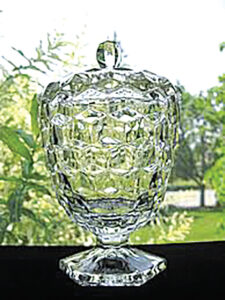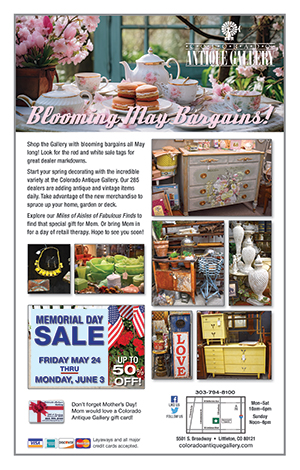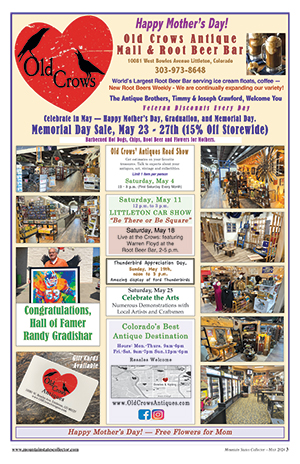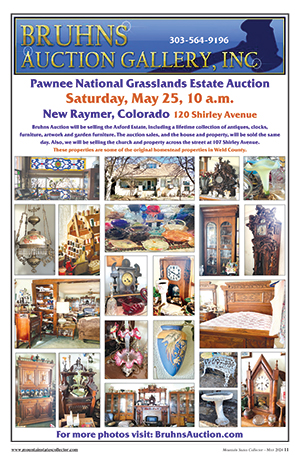 By Robert Reed
By Robert Reed One of the major ironies of the 19th century is how the lowly soda cracker came to be housed in the lovely and varied cracker jar.
Eventually cracker jars appeared in pottery, porcelain, wood, metal and the finest of art glass. Many bore elaborately decorated handles and bails, sometimes engraved and silver plated.
Distinguished cracker jars, of course, came in an amazing array of shapes and sizes. They could be round, square, or oval and often ranged in height from four inches to as much as 12 inches.
Throughout the 1700s sailors snacked on a special bread which would not spoil on long voyages. Made of wheat, cold water, and salt but without yeast they were shaped into hard flat forms for baking.
In 1792 a baker living near Boston, Massachusetts decided to commercially produce crackers which until then had been a home-made product. Theodore Pearson’s Ship Bread or Pilot Crackers became very popular in the seaports.
Another commercial baker, Josiah Bent adopted a similar process in 1801. Bent’s Hard Water Crackers were delivered to stores in the Boston area were sales were brisk from the beginning.
“All through the clipper ship era, sea biscuit or cracker bakers flourished,” according to Laurence Johnson author of the fine book Over The Counter and On The Shelf. “And when gold was discovered in California in 1849, crackers proved as satisfactory a staple for adventurers on land as for sailors on sea.”
During the Civil War, according to Johnson, a product similar to Pearson’s Ship Bread and Bent’s Hard Water Crackers became a standard army ration known as hardtack.
Crackers tended to be part of nearly every meal following the war era, and soon there was a demand for cracker jars in elegant Victorian fashion for dining guests.
Similar containers were produced by the British in the form of Jasperware china from William Adams and Sons of Staffordshire, Bristol glass, and Royal Worcester porcelain. Some of the Royal Worcester issues were hand-painted with fancy nickel-plated mountings and footed bases.
Today fine examples are commonly known as biscuit jars. However the American cracker was not fully introduced in Europe until the latter half of the 19th century where it was re-named the biscuit.
By the latter 1860s biscuit or cracker jars made of cranberry glass were available for dining tables. The yellow-red glass containers often included gold leaf and flower decorations.
During the 1880s the choices of cracker jars were even more extensive and included two-toned red to amber Amberina glassware primarily from the New England Glass Company, and lovely Vasa Murrhina glassware from the art glass company of the same name in Sandwich, Massachusetts.
The Mount Washington Glass Company was in full production of cracker jars by the 1890s including various shades of Burmese glass, and the stunningly beautiful Crown Milano art glass with heavy enamel lines and silver-plated covers provided by the Pairpoint Manufacturing Company. Additionally, Pairpoint offered a highly stylish white glassware Wave Crest cracker jar. These artful pieces came painted in pastel colors and typically were decorated with flowers.
For more silver plate, the Manhattan Silver Plate Company produced hand-engraved cracker jars in the 1890s with silver lids and bales. Each bore the work ‘crackers’ etched across their glass base.
In 1895 Montgomery ward catalog advertised a “fine cracker jar” made at the Royal Bon factory in Germany. The ad proclaimed:
“The shape is exceedingly pretty, while the decoration is one of the neatest we have ever seen. It consists of clusters of small blue and red flowers put on under the glaze, so that it is impossible to wash or wear off.”
The cracker jar from the national catalog stood six and a half inches tall and sold for $1. Such jars were also available by the end of the 19th century from RS. Prussia in Europe and of Nippon porcelain in Japan, among other sources. Such production continued well into the 20th century.
Ultimately cracker jars became “almost as common as the caster set” on the Victorian table according to Carol Wallace author of Victorian Treasures (Abrams).
“Even after the gradual rise of national food brands in the latter 19th century, no food would have been served directly from the package,” adds Wallace. “In genteel circles it would have been considered extremely gauche to put a biscuit tin on the table.”
Decorated satin glass cracker jars, in both plain and diamond-quilted patter continued to be plentiful in the early 1900s, as did those of enameled ruby glass.
Leading glass and pottery manufacturers both in the United States and in other parts of the world continued to supply a very robust market at the dawn of the 20th century.
In 1904, The Youth’s Companion offered a cracker jar of German porcelain as a premium for one new subscription and 30 cents for packaging and handling.
The following year, the Benjamin Allen Company of Chicago advertised a fluted glass cracker jar with glass lid and decorative top for $2.45. A decorated opal glass version with silver-plated lid and bail listed at $3.45. John Mebane noted in the 1969 edition of Poor man’s Guide to Antique Collecting, that some potters turned out cracker containers in porcelain and pottery during the early 1900s for decoration by purchasers in their homes. “Some of these obviously decorated by amateurs are quite respectable in appearance,” observes Mebane, “but others indicate that their owners were practicing on them.”
The Sears and Roebuck catalog of 1908 proudly displayed a silver-plated cracker jar on Britannia metal. It bore fluted edge, and the satin finish glass base was engraved with the word ‘crackers’ similar to one produced earlier by Manhattan Silver Plate Company.
Noted the catalog:
“This cracker jar is our leader, made especially for us with the idea of furnishing our customers with the best in this class of merchandise, and in order to introduce our silver plated hollow ware we are selling this cracker jar at an extremely low figure.”
While the popularity Victorian table settings in general and cracker jars in particular had declined before the onset of World War I, many American potteries and glass houses continued unflaggingly to offer at least some selections.
Fostoria Glass Company of Fostoria, Ohio, for example, continued to provided their various crystal pressed glass and gold decorated cracker jars through the 1920s.
Nearly 30 years ago author Melbane concluded that cracker jars will long be treasured, “as a prime example of a utilitarian object that can also be beautiful.”

















Follow Us